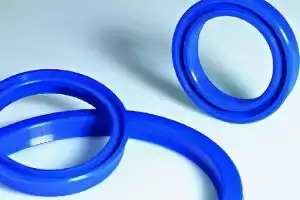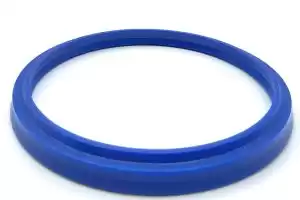Polytetrafluoroethylene PTFE
PTFE is a polymer made by polymerizing tetrafluoroethylene as a monomer
Advantages: •High and low-temperature resistance, can be used for a long time at temperatures from -180°C to 260°C.
•Corrosion resistance: resistant to almost all chemical substances except molten alkali metals and certain strong oxidants.
•Weather resistant and has the best aging resistance life among plastics.
• It has low friction, no substance will adhere, and it has the lowest friction coefficient among fixed materials.
Disadvantages: •The expansion coefficient is significant, and the size is manageable to change when the temperature changes, affecting the sealing effect.
•Higher price compared to other sealing materials.
Natural rubber NR
NR is mainly made of rubber hydrocarbon (polyisoprene) and contains a small amount of protein, moisture, resin acid, sugar, and inorganic salts. It is made from latex collected from rubber trees.
Advantages: • It has good wear resistance, high elasticity, tear strength, and elongation.
Disadvantages: •Poor oxygen and ozone resistance, easy to age in the air, become sticky when exposed to heat, easy to expand and dissolve in mineral oil or gasoline, resistant to alkali but not strong acid.
It is used as a raw material for making tapes, hoses, and rubber shoes. It is also suitable for making shock-absorbing parts and products used in liquids containing hydroxyl radicals, such as automobile brake fluid and ethanol.
Nitrile rubber NBR
NBR is copolymerized by acrylonitrile and butadiene. The acrylonitrile content is 18%~50%. The higher the acrylonitrile content, the better the resistance to petrochemical hydrocarbon fuel oil, but the low-temperature performance becomes worse. , the general operating temperature range is -25~100 ℃, mainly used to manufacture various oil-resistant products, such as hoses, sealing products, etc. NBR is one of the most commonly used rubbers for oil seals and O-rings.
Advantages: •Wear resistance, heat resistance, good air tightness, good oil resistance, water resistance, solvent resistance, and high-pressure oil resistance.
• It has sound compression distortion, wear resistance, and elongation strength.
Disadvantages: •Not suitable for use in polar solvents, such as ketones, ozone, nitrohydrocarbons, MEK, and chloroform.
Used to make fuel tanks, lubricating oil tanks, and rubber parts used in fluid media such as petroleum-based hydraulic oil, gasoline, water, silicone grease, silicone oil, diester-based lubricating oil, glycol-based hydraulic oil, etc., especially sealing parts. It is the most widely used and lowest-cost rubber seal at present.
Hydrogenate Nitrile rubber HNBR
A copolymer of butadiene and acrylonitrile. After hydrogenation, its temperature resistance and weather resistance are much higher than that of ordinary nitrile rubber, and its oil resistance is similar to that of regular nitrile rubber. The general operating temperature range is -25~150℃. Mainly used for oil-resistant and high-temperature-resistant sealing products.
Advantage:
• High mechanical strength and wear resistance
• Excellent corrosion resistance, tensile strength, tear resistance, and compression distortion properties.
• Good resistance to ozone, sunlight, and other atmospheric conditions.
• Generally suitable for use in laundry or dishwashing detergents.
Disadvantages:• Higher price than NBR.
Fluorine rubber FKM
FKM is a synthetic rubber containing fluorine atoms. The earliest fluorine rubber was poly-2-fluoro-1.3-butadiene and its copolymer with styrene, propylene, etc., which was trial-produced by DuPont Company in the United States in 1948. The currently widely used hexafluorinated fluorine rubber was produced by DuPont Company and Launched under the trade name “Viton.” It is more resistant to high temperatures than silicone rubber and has excellent chemical resistance, resistance to most oils and solvents (except ketones and esters), weather resistance, and ozone resistance; it is relatively less resistant to low temperatures, and the general use temperature range is -20~250 ℃. The unique formula can withstand low temperatures down to -40°C.
Advantages: • It has high chemical stability and has the best media resistance among all elastomers currently.
• High temperature resistance up to 250 ℃, short-term use up to 300 ℃
• Aging resistance
Disadvantages: • Not recommended for use with ketones, low molecular weight esters, and nitrate-containing mixtures.
It can be used in various seals, automobiles, locomotives, diesel engines, and fuel systems.
Polyurethane rubber PU
PU is a synthetic material that is wear-resistant, tear-resistant, and impact-resistant. It has excellent mechanical properties. Its high hardness, high elasticity, and wear resistance are unmatched by other rubbers. Aging resistance, ozone resistance, and oil resistance are also quite good. The general operating temperature range is -45~90℃.
Advantages: • Wear-resistant and high-pressure resistant
Disadvantages:• Not resistant to high temperatures
• Industrial high-pressure and wear-resistant seals, such as hydraulic cylinder seals.
• High voltage and high charge system.
Ethylene Propylene Diene Monomer rubber EPDM
EPDM is a copolymer of ethylene, propylene, and a small amount of non-conjugated diene. It is a type of ethylene-propylene rubber and a commonly used O-ring material. This material can be used to make sealing rings, etc., components that can ensure the durability and stability of the product.
Advantages: • Good weather resistance, ozone resistance, water resistance, and aging resistance; not easily affected by oxygen, heat, light, and ozone, maintaining the original performance, so it is suitable for long-term use environments.
• Corrosion resistance: Resistant to acids, alkalis, salts, and other chemical substances, suitable for a wide range of industrial fields.
Disadvantages: • Easily generate static electricity. The static electricity on its surface may affect its use. Measures need to be taken to eliminate or reduce static electricity.
•The vulcanization speed is slow, and the combination with other unsaturated rubbers is complex.
•The acid-base properties are relatively poor, and chemical changes are prone to occur in strong acid or alkali media.







